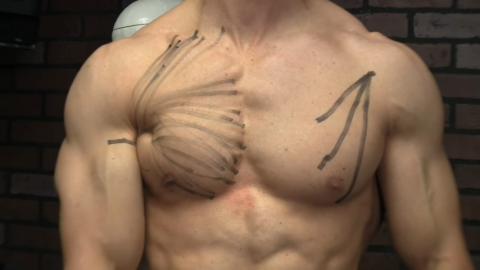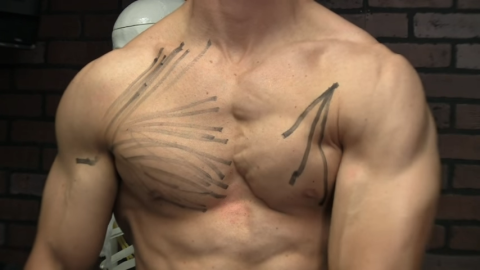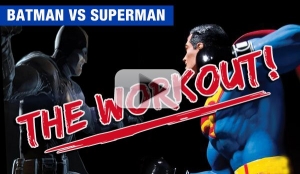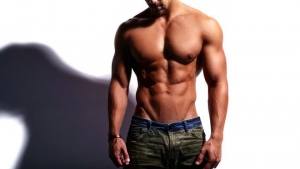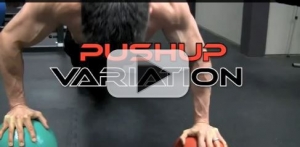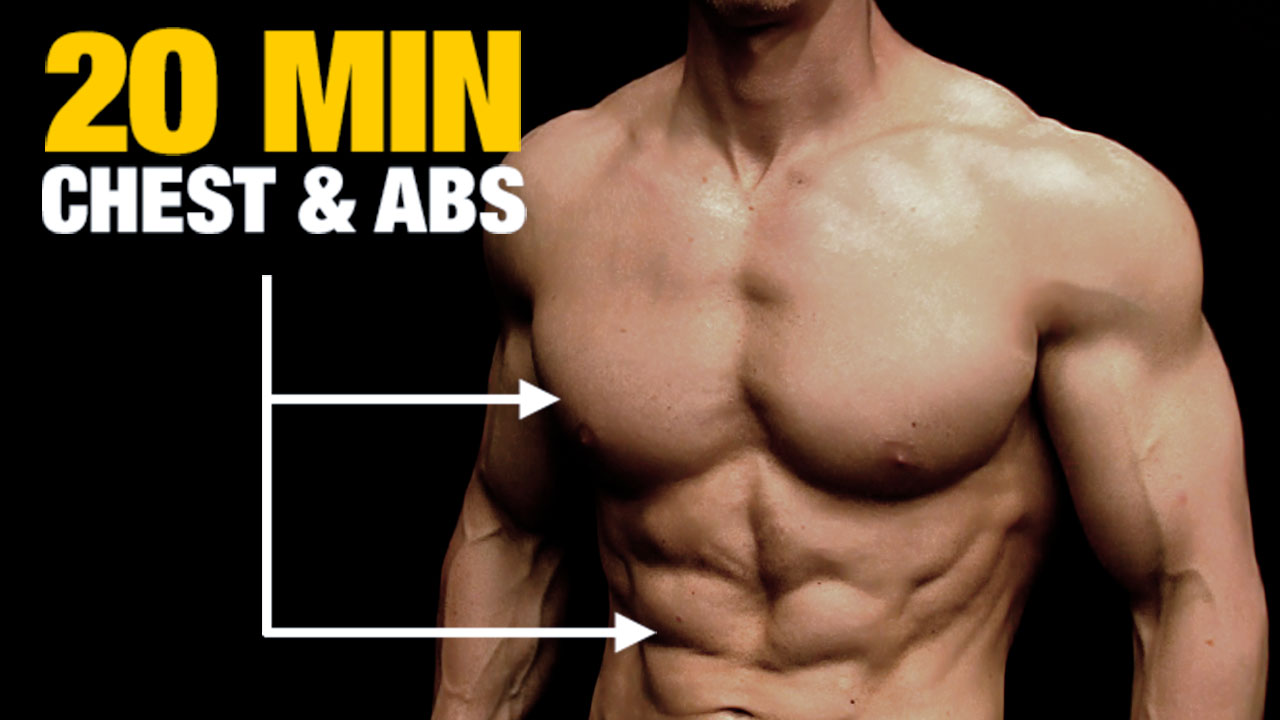
CAN YOU TRAIN CHEST AND ABS TOGETHER?
I pride myself on designing workouts that deliver fast, effective results by encouraging your muscles to work in harmony, just as they’re meant to.
Sometimes, there’s a pair of muscle groups that are so perfect for each other, but people often overlook them.
In this case, I’m talking about the chest and the abdominals.
Surprisingly, the chest and abs – both belonging to the anterior chain – make for an excellent team when trained correctly.
Today, I’m going to introduce you to a workout that simultaneously engages your chest and abs in each exercise.
This powerful combination not only helps you sculpt a strong, impressive chest, but also reinforces your core strength and aesthetics along the way.
The pectoralis major, a prominent and essential muscle within the pectoral muscle group, is the largest of the pectoral muscles.
Its anatomical structure spans from the sternum and clavicle to the humerus, covering a significant portion of the chest.
This muscle plays a vital role in various upper body movements and is primarily responsible for adducting and medially rotating the shoulder joint. Consequently, the pectoralis major facilitates the smooth motion of the arm across the body.
To effectively target and strengthen the pectoralis major, consider incorporating compound exercises such as the Bench Press. You can also incorporate some of my favorite chest exercises like the Incline Dumbbell Bench Press and the Cable Crossover.
These exercises are great for muscle building and development, especially when muscle growth is your primary focus.
PECTORALIS MINOR
The pectoralis minor, though smaller and lesser known than its counterpart, the pectoralis major, is an essential muscle that plays a significant role in the stability and functionality of the shoulder girdle.
Located beneath the pectoralis major, this fan-shaped muscle extends from the third to the fifth rib and attaches to the coracoid process of the scapula.
The primary function of the pectoralis minor is to stabilize the scapula by depressing and protracting it, which aids in the overall movement and control of the shoulder joint. Additionally, it assists in downward rotation of the scapula when the shoulder is elevated.
To target and strengthen the pectoralis minor, I’d recommend the Push-Up Plus exercise along with the Low-to-High Cable Crossover. Try adding these into your pecs workouts for serious gains!
ANTERIOR DELTOID


The anterior deltoid is located at the front of the shoulders, covering the head of the humerus.
This muscle plays an indispensable role in maintaining stability and mobility within the shoulder joint, making it essential for various upper body movements.
The primary functions of the anterior deltoid include shoulder flexion, horizontal adduction, and internal rotation. These actions allow for a range of motions, such as lifting the arm forward and across the body, as well as rotating the arm inward.
To get after and strengthen the anterior deltoid, I’d recommend the Overhead Press, and Push-Up.
RECTUS ABDOMINIS


The rectus abdominis, commonly referred to as the “six-pack” muscle, is the central muscle of the abdominal region.
It extends vertically from the pubic symphysis to the lower ribs and sternum, playing a vital role in core stability, balance, and posture.
The primary functions of the rectus abdominis include spinal flexion, lateral flexion, and stabilization of the trunk during various movements. It allows for actions such as bending forward at the waist and assisting in maintaining an upright posture.
I’m a fan of V-Ups, Hanging Leg Raises, and Reverse Crunches for my abs combo workout.
EXTERNAL OBLIQUES

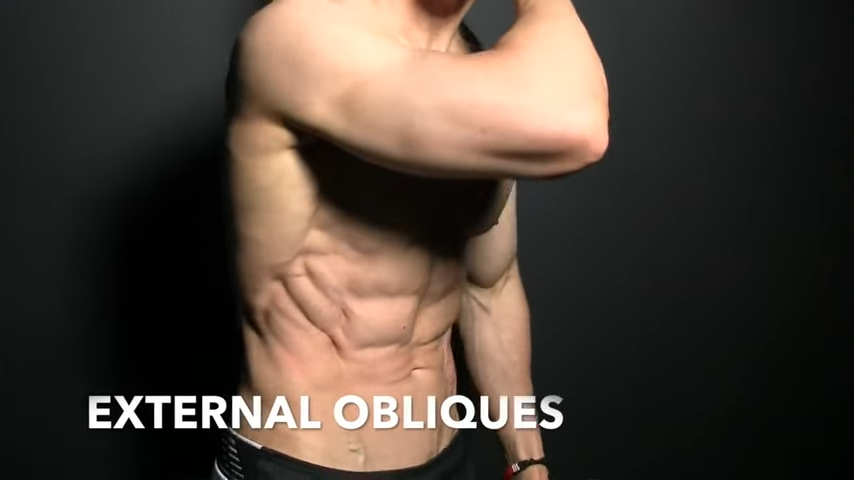
The external obliques are situated on the sides of the abdomen, extending from the lower ribs to the iliac crest of the pelvis.
These muscles are critical for maintaining core stability and facilitating various trunk movements.
The primary functions of the external obliques include trunk rotation, lateral flexion, and stabilization during core engagement. They enable actions such as twisting the torso, bending sideways, and providing support during dynamic movements.
Elbow to Knee Tucks and Side Bridges are excellent for targeting this muscle. I’d also get into the Side Plank position and dip your hips.
INTERNAL OBLIQUES

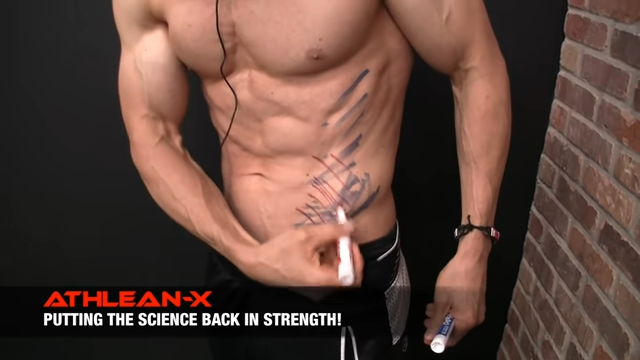
The internal obliques, an essential component of the abdominal muscle group, are located deep within the sides of the abdomen, beneath the external obliques.
They extend from the inguinal ligament and iliac crest up to the lower ribs, playing a crucial role in core stability and various trunk movements.
The primary functions of the internal obliques include trunk rotation, lateral flexion, and stabilization during core engagement. They enable actions such as twisting the torso, bending sideways, and providing support during dynamic movements, often working in tandem with the external obliques.
I’d recommend Windshield Wipers, Crossbody Mountain Climbers, and Side Bridges with Rotation if you want to target this muscle.
SERRATUS

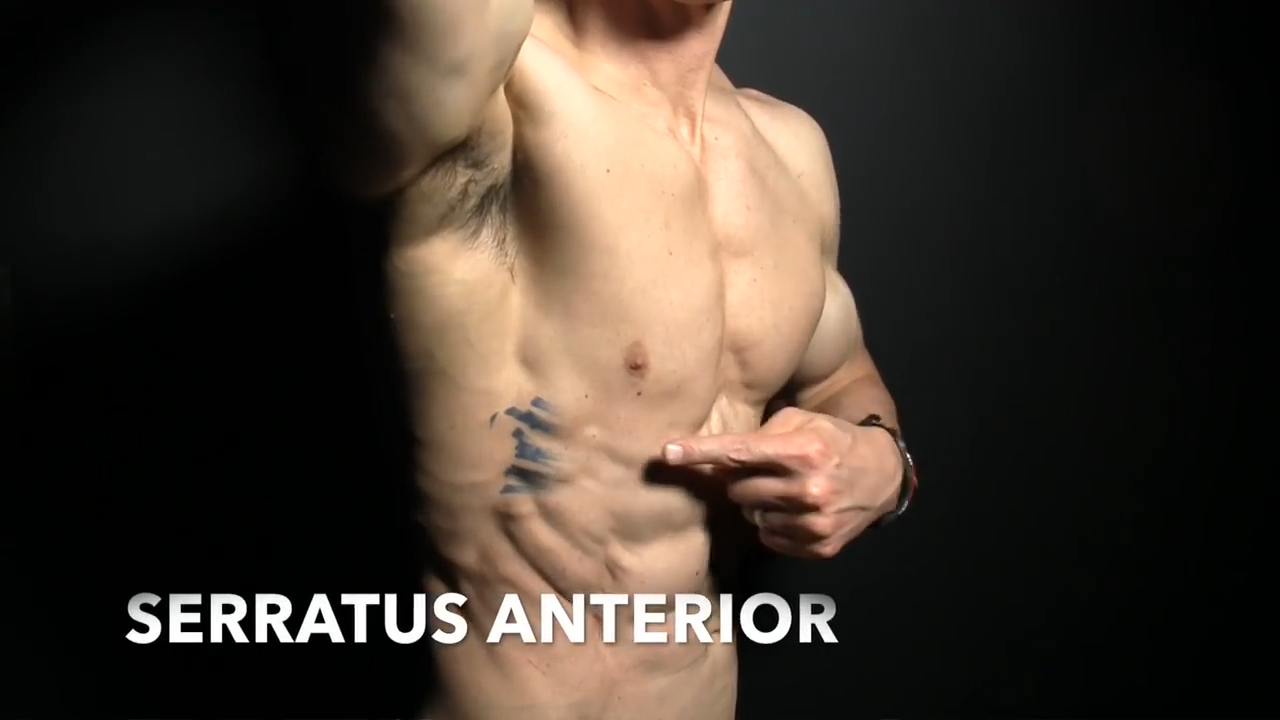
The serratus anterior, often simply referred to as the serratus, is a unique, serrated-shaped muscle located on the lateral aspect of the rib cage, beneath the scapula.
This muscle plays a crucial role in the stabilization and movement of the scapula, contributing to the proper functioning of the shoulder girdle.
The primary functions of the serratus anterior include scapular protraction, upward rotation, and stabilization during various upper body movements. These actions enable activities such as pushing, reaching, and maintaining proper scapular alignment, especially during overhead movements.
If you want to target this muscle, I’d recommend doing the Push-up Plus, Dumbbell Punches, and Overhead Press with Protraction.
TRANSVERSE ABDOMINIS


The transverse abdominis, often considered the body’s natural corset, is a deep, internal abdominal muscle that wraps horizontally around the torso.
It plays a critical role in core stability, posture, and supporting the spine during various movements.
The primary function of the transverse abdominis is to provide trunk stabilization by compressing the abdominal contents and maintaining intra-abdominal pressure. This action helps support the spine and maintain proper posture during dynamic and static activities.
CHEST AND ABS WORKOUT
Now that you know which muscles you’ll be targeting in this chest and abs workout, it’s time to learn the exercises.
Each chest exercise also targets the abdominal muscles so don’t be surprised when you feel it in both muscle groups.
And don’t worry, these aren’t super advanced ab exercises. They are all very moderate exercises that don’t have a steep learning curve.
Let’s get started with this step-by-step workout!
GYMNAST DIPS


HOW TO DO THE EXERCISE: Imagine doing a Chest Dip with a hip hinge thrown in at the end and you have the Gymnast Dip exercise. Start strong on a dip station, holding yourself up. Engage your core, bend at the elbows, and let yourself lower towards the floor. Watch the position of the arms by avoiding flaring out the elbows. Once your upper arms are parallel with the floor, pause and go back into the press-up position. At the top of the movement, contract your lower abs and lift your hips up, similar to an inverted V position. Pause for a moment before moving back to the starting position. Perform 3-4 sets per workout.
WHAT MAKES IT EFFECTIVE: Gymnast Dips are an excellent upper-body exercise that hit all the upper body anterior muscle groups. It combines the benefits of a Chest Dip with a hip hinge, adding an extra challenge for your lower abs. You can turn this into one of your new favorite weighted exercises with a dumbbell at your feet or a weight belt.
ONE-ARM INCLINE PRESS


HOW TO DO THE EXERCISE: Begin by adjusting an incline bench to approximately 45 degrees. Sit on the bench with your feet flat on the ground and your back pressed against the pad. Grab a dumbbell in one hand and hold it at shoulder height with your palm facing forward and your elbow bent at a 90-degree angle. Take a deep breath and engage your core. Press the dumbbell upward in a controlled motion until your arm is fully extended. Be sure to keep your wrist stable and maintain the dumbbell’s alignment above your shoulder. Pause briefly at the top of the movement, and then slowly lower the dumbbell back to the starting position, maintaining control throughout the descent.
WHAT MAKES IT EFFECTIVE: The One-Arm Incline Press is one of my go-to upper chest exercises. It’s an effective exercise due to its ability to isolate the chest, shoulder, and triceps muscles while engaging the core for stabilization just like the previous exercise. This unilateral exercise allows for a greater range of motion, helps identify and correct muscle imbalances, and adds an element of challenge to your workout routine.
ARCHER PUSHUPS

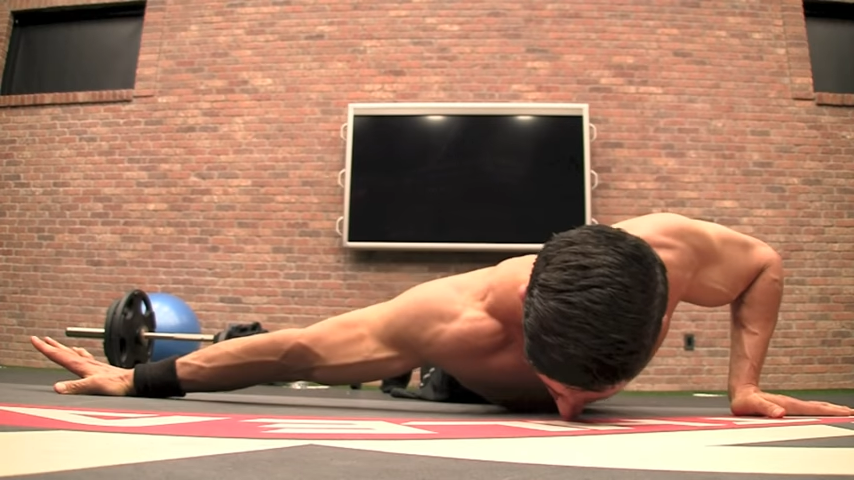
HOW TO DO THE EXERCISE: Start by getting into a standard pushup position with your hands wider than shoulder-width apart and your feet close together. Turn your hands slightly outward to accommodate the wider stance. Shift your body weight to one side while bending the elbow of that same side. Simultaneously, keep the opposite arm straight and slide it outward, mimicking the motion of drawing a bow. Lower your chest towards the ground, keeping your body in a straight line from head to heels. Push through the bent arm to lift your body back to the starting position while sliding the straight arm inward. Remember to keep your core engaged throughout the movement. Do as many Pushups per workout as you can with good form.
WHAT MAKES IT EFFECTIVE: This type of exercise is effective due to its ability to isolate one side of the chest, shoulder, and triceps muscles at a time. This unilateral exercise helps develop strength and balance, increases the range of motion, and addresses potential severe muscle imbalances. Moreover, the movement engages the core for stability, making it an excellent full-body exercise for your workout regimen.
3-D CROSSOVERS

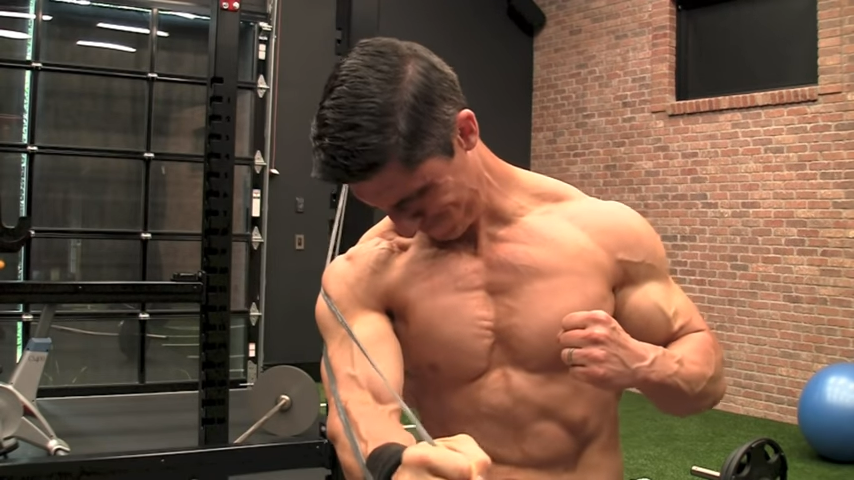
HOW TO DO THE EXERCISE: Set up a resistance band on a stable surface like a cable machine. Stand next to the band with your side facing it. Grab the band with the same side. Tighten your core and keep a slight bend in the elbow as you pull the band across your body. Pause and squeeze the chest muscles and core and then slowly return to the starting position. Repeat all the repetitions on the other side. You can also do this exercise with cables or a Cable Crossover machine if you don’t have access to resistance bands.
WHAT MAKES IT EFFECTIVE: The 3-D Crossover combines a chest and abdominal exercise and does so in the transverse – or rotational – plane of motion. This one is a must for your workout schedule.
HOW TO GET MORE OUT OF THIS WORKOUT
Getting the most out of these chest and abdominal movements is crucial for both time efficiency and achieving your fitness goals.
Try implementing the following tips and tricks to enhance the quality of your training sessions.
MOVE SLOWLY AND DELIBERATELY
Focusing on slow, controlled movements during strength training exercises helps activate and engage the targeted muscles more effectively.
By focusing on time under tension (TUT), you’ll ensure that your muscles work harder throughout the entire range of motion. This will promote strength, endurance, and muscle growth.
PRIORITIZE INTENSITY
Instead of focusing solely on the number of repetitions, prioritize an intense workout.
Choose weights that challenge your muscles to the point of fatigue but allow you to maintain proper form throughout the exercise.
In other words, trade in your heavy weights for more intensity, especially if the heavy lifts make you sacrifice your form.
TRY SUPERSETS
Supersets involve performing two exercises back-to-back without any rest in between, targeting the opposing muscle group.
For example, perform a set of Gymnast Dips and then do a Lat Pulldown.
You can also target the same muscle group. This is called a compound set.
For example, after a set of Bench Press, you perform the 3-D Crossover.
This technique increases workout intensity, saves time, and promotes muscle growth.
REST STRATEGICALLY
Rest periods between sets are essential for muscle recovery and preventing burnout. However, the optimal rest duration depends on your goals and the type of exercise.
Generally, shorter rest periods (30-60 seconds) are suitable for endurance and hypertrophy-focused workouts, while longer rest periods (2-5 minutes) are recommended for strength and power training.
FOCUS ON PROGRESSIVE OVERLOAD
To keep improving and avoid plateaus, consistently challenge your body by gradually increasing the resistance, volume, or intensity of your workouts.
Keep in mind that you wouldn’t increase all three at the same time!
This principle, called progressive overload, ensures continuous progress and adaptation, ultimately leading to enhanced performance and results.
MAINTAIN PROPER FORM
Proper form is crucial for preventing injuries and maximizing the effectiveness of each exercise.
Always prioritize maintaining good form over lifting heavier weights or performing more repetitions.
If needed, seek guidance from a fitness professional to ensure you’re executing each movement correctly.
Guys, if you’re already targeting lower and upper chest exercises anyway, why not tweak the movements a bit to incorporate your abs?
These two-for-one exercises will help you strengthen and build your chest while sculpting those core muscles.
Looking for more chest workouts or core workouts? We can help! Check out our ATHLEAN-X programs to see which is the best fit for your goals and fitness level!

- The chest and abs make a perfect pair. Best of all, they are right next to each other so you can incorporate one while training the other.
- Here are four chest exercises that also act as a perfect abs workout:
- The Gymnast Dip exercise combines a chest dip with a hip hinge at the end of the movement. Begin on a dip station, lower yourself by bending the elbows, push back up, and at the top, contract your lower abs while lifting your hips up before returning to the starting position.
- The One-Arm Dumbbell Press starts with an incline bench set to 45 degrees, holding a dumbbell at shoulder level with a bent elbow. Engage your core and press the dumbbell upward until your arm is fully extended, then slowly lower it back down, maintaining control throughout the movement.
- Archer Push-Ups begin in a standard push-up position with hands wider than shoulder-width and turned slightly outward. Shift body weight to one side while bending the elbow, slide the opposite straight arm outward, and lower your chest to the ground, then push back up and slide the straight arm inward, engaging your core throughout.
- In the 3-D Crossover, stand beside a resistance band attached to a stable surface like a cable station, grabbing it with the same side hand. With a tight core and slightly bent elbow, pull the band across your body, pause and squeeze chest muscles, then slowly return to the starting position and repeat on the other side.
CHEST AND ABS WORKOUT FAQS
Yes, you can do abs after a chest workout. As most of you might already know (and do), it is a common practice to combine muscle groups in a single session.
By working on your chest first, you will have the energy and focus required for the primary compound movements.
Then, you can finish with ab exercises to target your core muscles.
Always prioritize proper form and technique to avoid injury.
Absolutely, working out chest and abs on the same day is a popular approach, especially for those following an upper/lower body split or a push/pull/legs (PPL) workout routine.
This allows you to save time and hit multiple muscle groups in one session.
Combining these muscle groups can also help improve overall strength and stability.
Just make sure to give your muscles enough time to recover between sessions to reduce the risk of injuries like muscle tears.
There is no single "best" workout for abs and chest, as individual preferences, goals, and fitness levels will vary.
However, here are some effective exercises that target both muscle groups at the same time:
- Gymnast Dips
- One-arm Incline Press
- Archer Pushups
- 3-D Crossovers
- Focus Hollow Body Floor Press
- Push-Ups
You can also superset a chest exercise with a core exercise. For example, try performing Weighted Leg Lifts followed by an explosive movement like Plyo Push-Ups.

Jeff Cavaliere M.S.P.T, CSCS
Jeff Cavaliere is a Physical Therapist, Strength Coach and creator of the ATHLEAN-X Training Programs and ATHLEAN-Rx Supplements. He has a Masters in Physical Therapy (MSPT) and has worked as Head Physical Therapist for the New York Mets, as well as training many elite professional athletes in Major League Baseball, NFL, MMA and professional wrestling. His programs produce “next level” achievements in muscle size, strength and performance for professional athletes and anyone looking to build a muscular athletic physique.
















